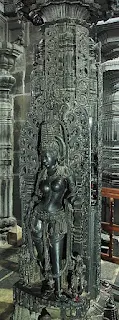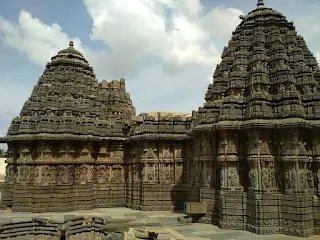Hoysala Temple Architecture
Beautiful artifacts of human work are frequently left behind by the subtle dance of time. In Indian architecture, the Hoysala style is a monument to the inventiveness of its craftsmen. Let's take a trip back in time to discover the fascinating background of the old Indian temple building in the Hoysala style.
Overview
India's past
was a melting pot of many customs, cultures, and architectural wonders. Among
these, a gem in India's architectural crown is the Hoysala style, which
originated in the southern state of Karnataka. This Hoysala dynasty-era temple
architecture flourished, firmly rooted in rich historical and cultural themes,
and left an enduring impression on the South Indian environment.
Origins of Hoysala Style
Early Influences
To understand the genesis
of the Hoysala style, one must delve into the melting pot of influences that
shaped it. Drawing from the architectural heritage of the Chalukyas, Pallavas,
and Cholas, the artisans of the Hoysala dynasty amalgamated various elements to
forge a distinctive aesthetic identity.
Emergence in Karnataka
The fertile soil of
Karnataka provided the perfect canvas for the blossoming of the Hoysala style.
From the 11th to the 14th centuries, under the patronage of the Hoysala rulers,
a plethora of temples adorned the landscape, each a masterpiece of architectural
finesse and artistic ingenuity.
Key Features of Hoysala
Style
Architecture Elements
At the heart of Hoysala
architecture lies a harmonious blend of intricate carvings, exquisite pillars,
and elaborate ceilings. Characterized by star-shaped plans and intricately
carved outer walls, Hoysala temples are a marvel of geometric precision and
artistic expression.
Sculptural Ornamentation
The hallmark of Hoysala
temples is their profusion of sculptural embellishments. From celestial beings
to mythical creatures, every inch of the temple facade is adorned with
intricate carvings that narrate tales of gods, goddesses, and epic legends.
Symbolism and Iconography
Central to the Hoysala
ethos is the infusion of profound symbolism and iconography into architectural
design. Every motif, every sculpture carries layers of meaning, inviting
devotees into a realm where spirituality and art intertwine seamlessly.
Prominent Hoysala Temples
Belur Chennakesava Temple
Nestled amidst the quaint
town of Belur, the Chennakesava Temple stands as a crowning jewel of Hoysala
architecture. Adorned with an array of sculptural wonders, this temple is a
testament to the exquisite craftsmanship of yesteryears.
Halebidu Hoysaleswara
Temple
In the ancient town of
Halebidu, the Hoysaleswara Temple stands as a towering edifice of architectural
grandeur. From its intricately carved walls to its imposing monolithic pillars,
every facet of this temple resonates with the spirit of divine craftsmanship.
Somnathpur Chennakesava
Temple
Located in the serene
village of Somnathpur, the Chennakesava Temple enchants visitors with its
architectural splendor. Despite the ravages of time, this temple remains a
shining example of Hoysala artistry, drawing pilgrims and tourists alike to its
hallowed precincts.
Significance and Legacy
Influence on Subsequent
Architecture
The legacy of the Hosyala
style reverberates far beyond the confines of Karnataka, influencing subsequent
architectural styles across India. From the towering gopurams of Tamil Nadu to
the ornate temples of Andhra Pradesh, echoes of Hosyala craftsmanship endure
through the ages.
Cultural and Religious
Impact
Beyond its architectural
brilliance, the Hoysala style embodies the cultural and religious ethos of
medieval India. Through its temples, the Hoysala dynasty fostered a deep sense
of piety and devotion among the masses, shaping the spiritual landscape of the
region for centuries to come.
Preservation Efforts
Challenges
Despite its enduring
beauty, Hoysala architecture faces myriad challenges, including natural
calamities, urbanization, and neglect. The delicate intricacies of its carvings
and sculptures demand meticulous preservation efforts to safeguard this
invaluable heritage for future generations.
Conservation Initiatives
Recognizing the urgent
need to preserve this architectural legacy, various governmental and
non-governmental organizations have embarked on conservation initiatives.
Through collaborative efforts, steps are being taken to restore and protect
Hosyala temples, ensuring that their splendor remains undimmed by the passage
of time.
Conclusion
In the tapestry of
India's architectural heritage, the Hoysala style shines as a radiant thread,
weaving together the stories of bygone eras and the aspirations of future
generations. From the towering spires of Belur to the serene courtyards of
Somnathpur, each temple bears witness to the timeless legacy of Hoysala
craftsmanship, beckoning travelers on a journey through the annals of history.
FAQs
What distinguishes the Hoysala
style from other Indian architectural styles?
The Hoysala style is
characterized by its intricate carvings, star-shaped plans, and profusion of
sculptural ornamentation, setting it apart from other regional architectural
styles in India.
How were Hosyala temples
constructed without modern technology?
Hosyala artisans relied
on traditional methods and craftsmanship passed down through generations to
construct temples, employing techniques such as stone carving, sculpting, and
intricate detailing by hand.
Why are Hoysala temples
significant in Indian history?
Hoysala temples serve as
tangible markers of India's rich cultural and architectural heritage,
reflecting the spiritual and artistic pursuits of medieval Indian society under
the patronage of the Hoysala dynasty.
What challenges do
conservation efforts face in preserving Hoysala temples?
Conservation efforts for Hoysala
temples face challenges such as funding constraints, lack of skilled manpower,
and the delicate nature of the architectural elements, requiring specialized
expertise for restoration and maintenance.
Are there any modern
influences on the preservation of Hoysala temples?
Yes, modern technologies
such as 3D scanning, digital mapping, and advanced conservation techniques are
increasingly being employed in preservation efforts to ensure the longevity and
integrity of Hoysala temples for future generations.




.jpg)
